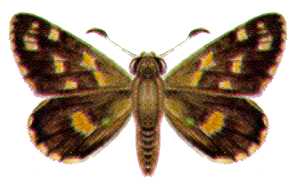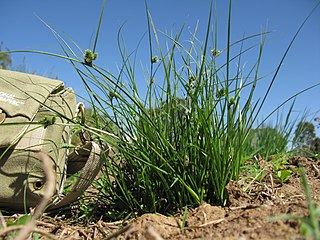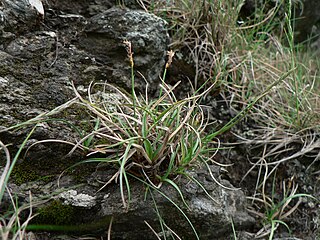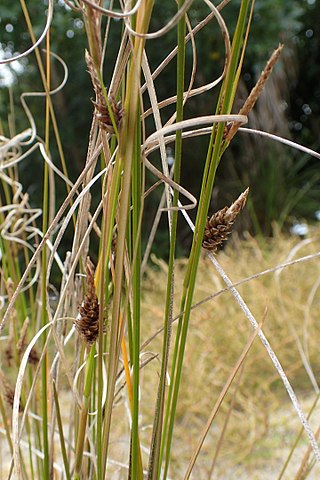
Hesperilla munionga, the alpine sedge-skipper, is a butterfly of the family Hesperiidae. It is found in the Australian Capital Territory, New South Wales, Tasmania and Victoria.

Carex sect. Spirostachyae is a section of the genus Carex, containing 38 species of sedge. Species in Carex sect. Spirostachyae share a suite of features, including the short internodes of the primary rhizomes, the presence of an antiligule, the leaf-like, sheathing bract at the base of the inflorescence, the presence of three stigmas in female flowers, and the shape of the seeds.

Carex archeri, known as Archer's sedge, is a species of sedge in the genus Carex, endemic to south-eastern Australia.
Carex bichenoviana, the plains sedge, is a species of sedge that was first formally named by Francis Boott in 1858. It is native to eastern Australia and has been introduced to New Zealand. It has previously been considered a variety of Carex pumila.

Carex capillacea, common name yellowleaf sedge in Tasmania, is a species of sedge found in Assam, the far east of Russia, New Guinea, south east Australia, New Zealand, Malesia, China, Japan and India.

Carex appressa, the tall sedge, is a species of flowering plant in the family Cyperaceae. It is native to New Guinea, Australia, New Zealand, and generally in the South West Pacific.

Carex rosea, the rosy sedge, is a flowering plant and part of the family Cyperaceae. Synonyms for Carex rosea include Carex concoluta, and Carex flaccidula. It is native to central and eastern North America and it exists in wet to dry soils. Carex rosea can be found in shores of streams and bottomlands, as well as ponds. It is known to have good adaptations to dry-shade locations. It is an evergreen plant which is easy to grow.

Carex fascicularis, commonly known as tassel sedge, is a species of sedge of the family Cyperaceae that is native to Australia, New Zealand and New Guinea.

Carex inversa, commonly known as knob sedge, is a species of sedge of the family Cyperaceae that is native to parts of Australia and New Zealand and has also been introduced into Great Britain.
Carex tereticaulis, also known as basket sedge, is a species of sedge of the family Cyperaceae that is native to southern parts of Western Australia, southern parts of South Australia, southern and eastern parts of New South Wales as well as north western and central Victoria and Tasmania. The Koori peoples know the plant as Poong'ort.

Carex rupestris, called the curly sedge and rock sedge, is a species of flowering plant in the family Cyperaceae, native to temperate and subarctic North America, Greenland, Iceland, Europe, and Asia. It prefers to grow on rocky ledges.

Carex divulsa, the grey sedge, is a species of flowering plant in the genus Carex, native to Macaronesia, Europe, northwest Africa, the Caucasus region, and the Middle East as far east as Turkmenistan. It has been introduced to northeast Argentina, the District of Columbia and Pennsylvania in the United States, Ontario in Canada, the North Island of New Zealand, and Tasmania and Victoria in Australia. It is the namesake of the Carex divulsa aggregate.

Carex breviculmis, called the Asian shortstem sedge, is a species of flowering plant in the genus Carex, native to Asia from the Indian subcontinent to Southeast Asia, China, Taiwan, Korea, Japan, north as far as Khabarovsk Krai, and Malesia, New Guinea, Australia, Norfolk Island and New Zealand. It has been introduced to the US state of Mississippi. Typically found in forests, it is quite shade tolerant.

Carex lachenalii, called the twotipped sedge and hare's foot sedge, is a species of flowering plant in the genus Carex, native to temperate and subarctic North America, Greenland, Iceland, Europe, and Asia, and the South Island of New Zealand. Its diploid chromosome number is 2n=64, with some uncertainty.
Carex tasmanica, called curly sedge, is a species of flowering plant in the family Cyperaceae, native to Victoria and Tasmania states in Australia. It gets its common name from the distinctive helical spirals its leaves form when they dry out. Considered a threatened species, none of its populations are in a protected area.

Carex gaudichaudiana, also known as fen sedge, is a tussock-forming species of perennial sedge in the family Cyperaceae. It is native to parts of Australia and New Zealand.

Carex litorosa, commonly known as sea sedge, is a tussock-forming species of perennial sedge in the family Cyperaceae. It is native to New Zealand.
Carex alsophila, commonly known as forest sedge, is a tussock-forming species of perennial sedge in the family Cyperaceae. It is native to Victoria in south eastern Australia.
Carex cephalotes, also known as wire-head sedge, is a tussock-forming species of perennial sedge in the family Cyperaceae. It is native to south eastern Australia and New Zealand.
Carex polyantha, commonly known as river sedge, is a tussock-forming species of perennial sedge in the family Cyperaceae. It is native to eastern parts of Australia.













